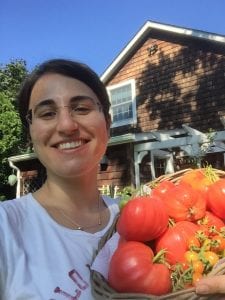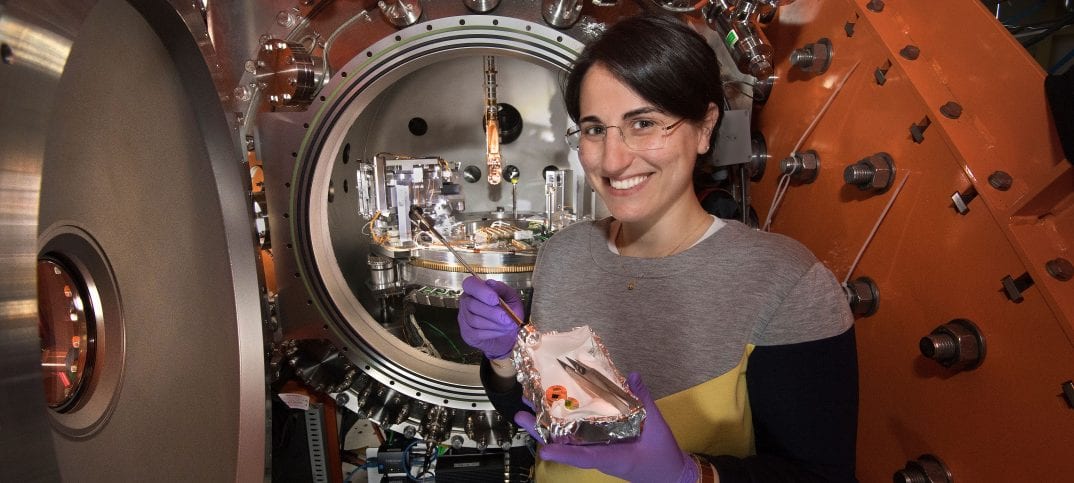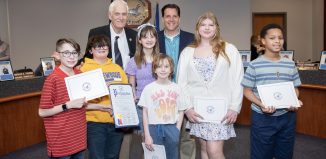By Daniel Dunaief
Nature plays a wonderful game of hide-and-seek with its secrets.
One day, Joan might be searching for, say, an apple tree in the forest. Joan might consider all the elements that appeal to an apple tree. She might expect the journey to take two hours but, to her surprise, discovers a tree on the way.
That’s what happened to Valentina Bisogni, a physicist at Brookhaven National Laboratory. Bisogni, who works at the National Synchrotron Lightsource II, wanted to figure out how the thickness in a magnetic film affected traveling modes involving the spin property of electrons, known as spin waves. Specifically, she wanted to control the energy of the spin wave.
This might be important in future devices that involve passing along information through an electron’s spin rather than through charge, which is the current method. Controlling the spin wave could be another way to optimize the performance or improve the efficiency of future devices.
Transmitting charge creates unwanted heat, which can damage the components of an electronic device and limit its usefulness. Heat also creates energy inefficiencies.

Bisogni, who arrived at BNL in 2014, has been working on a beamline called Soft Inelastic X-ray Scattering, or SIX. Each of the new beamlines at the nearly billion-dollar facility has its own acronym and number that corresponds to their location in the accelerator ring.
Before she planned to apply an electric field that might control the spin wave, however, Bisogni figured she’d explore the way thinner iron materials affected the spin.
That’s when the metaphorical apple tree appeared, as the thickness of iron films, that were as thin as one to 10 nanometers, helped control the spin wave before applying any electric field.
“This result was not expected,” Bisogni said. This was preparatory work to a more detailed, dedicated study.
“Not having had any benchmark of iron crystals in general with the technique I am using, it was logical to study this system from a bulk/ thin form to a very thin film,” she explained in an email.
Bisogni and a team from Yale University recently published the results of this work in the journal Nature Materials.
While this unexpected result is encouraging and could eventually contribute to the manufacture of electronic devices, Bisogni said this type of discovery helps build a fundamental understanding of the materials and their properties at this size.
“For people assembling or designing devices or wave guides, I think this is an ingredient that has to be considered in the future,” Bisogni said.
This kind of result could enable the optimization of device performance. When manufacturers propagate a signal based on spin dynamics, they would likely want to keep the same frequency, matching the signal along a medium from point A to point B.
The effect of the thickness on the spin was like a power log, which is not quite exponential as the experimenters tested thinner material, she said.
Bisogni plans to continue with this collaboration, as the group is “excellent in preparing and characterizing this kind of system.”
In the bigger picture, Bisogni is focused on quantum materials and altering their spin.
She is also overseeing the development of a system called Opera, which copies the working conditions of electronic devices. Opera is the new sample environment available at SIX and is developed within the research project to copy device-working conditions in the beamline’s measurement chamber.
Bisogni ultimately hopes her work may improve the energy efficiency of electronics.
A resident of Bellport Village, Bisogni lives with her partner Claudio Mazoli, who is the lead scientist for another beamline at the NSLS II, called the Coherent Soft X-ray Scattering, or CSX.
Bisogni said the couple frequently enjoy exchanging ideas and have an ongoing active collaboration, as they share several scientific passions.
The couple met at the European Synchrotron Radiation Facility in Grenoble, France when they were working in the same lab.
Bisogni was born and raised in Spoleto, which is in the province of Perugia in the center of Italy. Bisogni speaks Italian and English as well as French and German after her work experience in France, Germany and Switzerland.
Bisogni said she and Mazoli are “very food-centric” and can find numerous epicurean opportunities in the area of Long Island and New York City. The weather is also similar to home, although they miss their family and friends from Italy.
The couple purchased a house together during the pandemic and have been doing some work to shape the house to their needs. They remodeled the bathrooms in an Italian/ European style, purchased a German washing machine and dryer and painted some walls.
In the summer, Bisogni, who likes to eat, cook and grow vegetables, enjoys spinach, tomatoes and light-green zucchini.
As for her work, Bisogni is currently pleased with the state of her beamline, although she said its development took considerable team effort and time during the development, construction and commissioning.
At this point, her research team includes two and a half permanent scientists and two post-doctoral scientists. Within the team, they have two post-doc researcher positions looking to fill, one for her research project and another dedicated to her colleague’s research project.
Ultimately, Bisogni is excited with the opportunities to make fundamental discoveries at work.
“It is, in general, very exciting, as most likely you are doing something for the first time,” Bisogni explained in an email. “It is true that you may fail, since nobody is going to tell you if what you are doing is going to work or not, but if you get it right, then it is extremely rewarding.”







